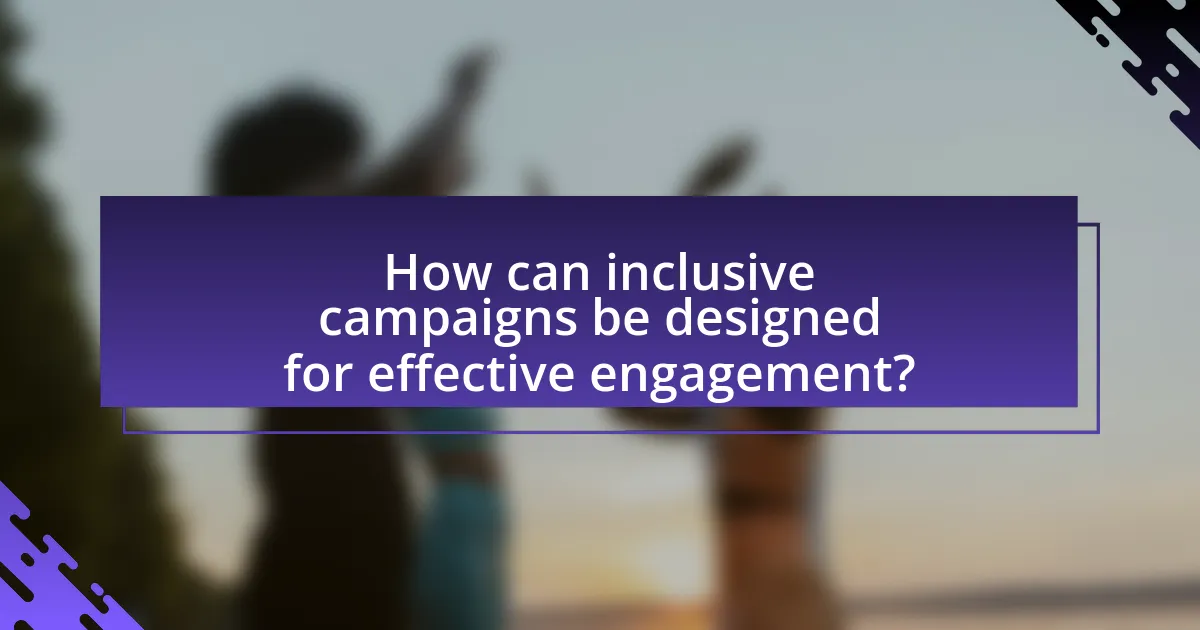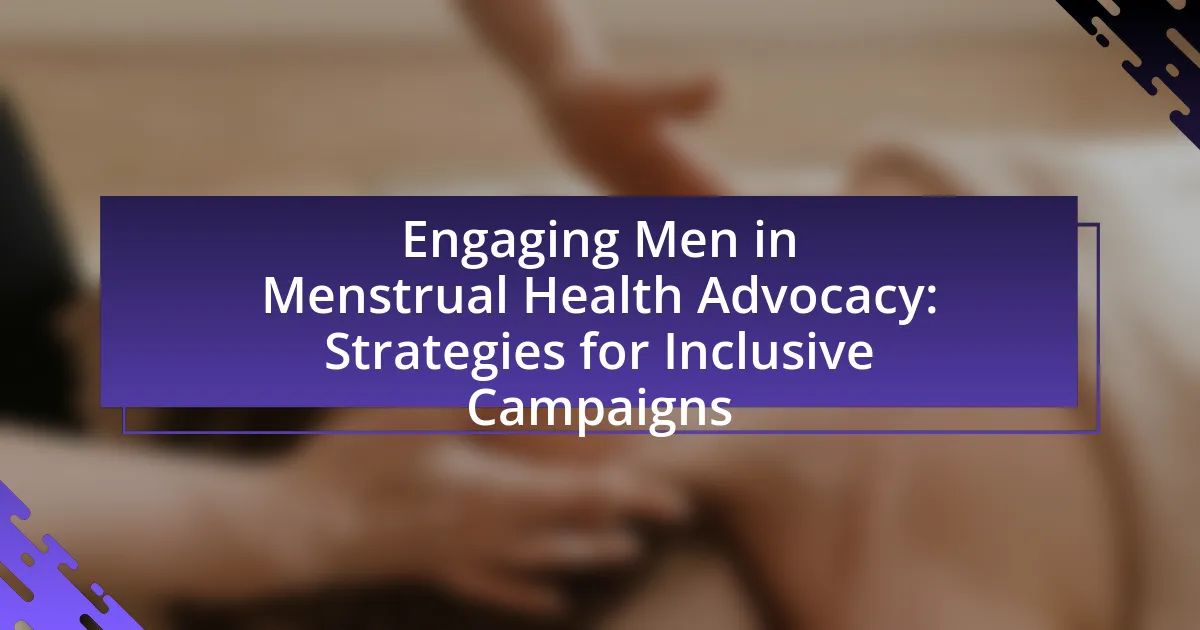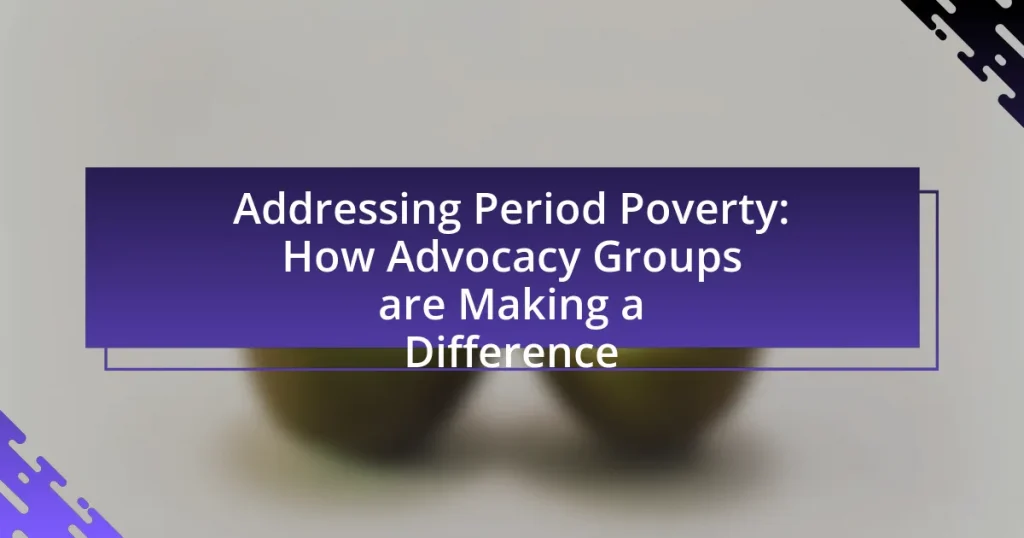Engaging men in menstrual health advocacy is a critical approach aimed at fostering understanding and support for menstrual equity. This article explores the importance of involving men in discussions about menstrual health, highlighting how their participation can challenge societal stigma, promote shared responsibility, and improve access to menstrual products and services. Key challenges such as cultural perceptions, misconceptions, and societal stigma that hinder men’s involvement are examined, along with effective strategies for engagement, including education, collaboration, and inclusive campaigns. The article emphasizes the role of media and feedback in shaping advocacy efforts, ultimately aiming to create a more supportive environment for all individuals affected by menstruation.

What is Engaging Men in Menstrual Health Advocacy?
Engaging men in menstrual health advocacy involves actively involving men in discussions and initiatives related to menstrual health, aiming to foster understanding and support for menstrual equity. This engagement is crucial as it helps to challenge stigma, promote shared responsibility, and create a more inclusive dialogue around menstrual health issues. Research indicates that when men are educated about menstrual health, they can become allies in advocating for policies and practices that support menstrual hygiene management, ultimately benefiting everyone in the community.
Why is it important to involve men in menstrual health advocacy?
Involving men in menstrual health advocacy is crucial because it fosters a supportive environment that can help dismantle stigma and promote understanding. Men play a significant role in shaping societal attitudes and behaviors; their involvement can lead to increased awareness and education about menstrual health issues. Research indicates that when men are engaged in discussions about menstrual health, it can lead to improved support for women and girls, as well as better access to menstrual products and services. For instance, a study published in the journal “Global Health: Science and Practice” highlights that male involvement in menstrual health initiatives can enhance community acceptance and reduce taboos surrounding menstruation, ultimately benefiting public health outcomes.
What are the societal perceptions of menstruation that affect men’s involvement?
Societal perceptions of menstruation often portray it as a taboo subject, which significantly limits men’s involvement in menstrual health advocacy. These perceptions stem from cultural beliefs that associate menstruation with shame and secrecy, leading to discomfort among men discussing or engaging with the topic. For instance, a study published in the journal “Reproductive Health” highlights that in many cultures, menstruation is viewed as a private matter, discouraging open dialogue and participation from men. This lack of engagement is further reinforced by stereotypes that suggest menstruation is solely a women’s issue, thereby marginalizing men’s roles in supporting menstrual health initiatives.
How can men’s participation change the narrative around menstrual health?
Men’s participation can significantly change the narrative around menstrual health by fostering open dialogue and reducing stigma. When men engage in conversations about menstruation, they help normalize the topic, making it less taboo and more acceptable in society. Research indicates that inclusive campaigns that involve men can lead to greater awareness and understanding of menstrual health issues, as evidenced by initiatives like the “Menstrual Health for All” campaign, which highlights the importance of male allies in advocating for women’s health rights. By actively participating, men can challenge misconceptions and promote supportive environments, ultimately leading to improved menstrual health outcomes for all.
What are the key challenges in engaging men in this advocacy?
The key challenges in engaging men in menstrual health advocacy include societal stigma, lack of awareness, and perceived irrelevance. Societal stigma often discourages men from discussing menstrual health openly, leading to misconceptions and a lack of understanding about the topic. Additionally, many men may lack awareness of the issues surrounding menstrual health, as education on this subject is often limited to women. Furthermore, men may perceive menstrual health as a women’s issue, resulting in disengagement from advocacy efforts. These challenges hinder effective participation and support from men in menstrual health initiatives.
What misconceptions do men have about menstrual health?
Men often hold misconceptions about menstrual health, including the belief that menstruation is solely a hygiene issue rather than a complex biological process. This misunderstanding overlooks the hormonal, emotional, and physical aspects of menstruation, which can significantly affect women’s health and well-being. Additionally, many men mistakenly think that menstrual symptoms, such as cramps and mood swings, are exaggerated or not serious, failing to recognize that studies show up to 90% of women experience some form of menstrual discomfort, which can impact their daily activities and quality of life. Furthermore, there is a common belief that menstrual health is not a topic for male discussion, which perpetuates stigma and hinders open communication about women’s health issues.
How do cultural norms impact men’s willingness to engage?
Cultural norms significantly influence men’s willingness to engage in menstrual health advocacy by shaping perceptions of masculinity and societal roles. In many cultures, traditional views often associate discussions about menstruation with femininity, leading men to feel uncomfortable or reluctant to participate. For instance, a study published in the journal “BMC Public Health” found that men in societies with rigid gender norms were less likely to engage in conversations about menstrual health, as they feared being perceived as less masculine. This reluctance is further compounded by the stigma surrounding menstruation, which can discourage men from advocating for menstrual health initiatives. Thus, cultural norms create barriers that limit men’s involvement in these important discussions and advocacy efforts.

What strategies can be employed to engage men in menstrual health advocacy?
To engage men in menstrual health advocacy, strategies should include education, collaboration, and normalization of discussions around menstruation. Education initiatives can focus on providing accurate information about menstrual health, emphasizing its relevance to everyone, regardless of gender. Collaborative efforts with male influencers and community leaders can help amplify the message and reach a broader audience. Normalizing conversations about menstruation in various settings, such as workplaces and schools, can reduce stigma and encourage men to participate actively in advocacy efforts. Research indicates that inclusive campaigns that involve men can lead to increased awareness and support for menstrual health initiatives, ultimately fostering a more supportive environment for all individuals affected by menstruation.
How can education play a role in engaging men?
Education can engage men in menstrual health advocacy by providing them with accurate information and fostering understanding of the topic. By incorporating comprehensive sexual and reproductive health education in schools and community programs, men can learn about menstrual health, breaking down stigma and misconceptions. Research shows that informed individuals are more likely to support gender equality initiatives; for instance, a study published in the Journal of Adolescent Health found that education on menstrual health significantly increased male participants’ willingness to engage in advocacy efforts. This knowledge empowers men to become allies in promoting menstrual health, ultimately leading to more inclusive campaigns.
What educational resources are effective for men regarding menstrual health?
Effective educational resources for men regarding menstrual health include comprehensive online courses, workshops, and informational websites that focus on menstrual biology, stigma reduction, and the importance of menstrual health in overall well-being. For instance, organizations like Menstrual Health Hub provide resources tailored for men, emphasizing the role they can play in supporting menstrual health. Additionally, educational campaigns that utilize social media platforms have proven effective in reaching men, as they can engage with interactive content that demystifies menstruation and encourages open discussions. Research indicates that men who participate in educational programs about menstrual health are more likely to support menstrual equity initiatives, thereby fostering a more inclusive environment.
How can workshops and seminars be structured to include men?
Workshops and seminars can be structured to include men by incorporating diverse perspectives and creating a safe environment for open dialogue. This can be achieved by ensuring that the content addresses men’s roles in menstrual health advocacy, emphasizing shared responsibilities, and providing education on the topic. Research indicates that inclusive approaches, such as mixed-gender discussions and interactive activities, foster engagement and understanding among participants. For instance, a study published in the Journal of Men’s Health highlights that workshops that include male perspectives lead to increased awareness and support for menstrual health initiatives.
What role does media play in promoting men’s involvement?
Media plays a crucial role in promoting men’s involvement in menstrual health advocacy by shaping perceptions and encouraging dialogue. Through targeted campaigns, media can challenge stereotypes and normalize discussions around menstruation, making it a shared responsibility rather than a taboo subject. For instance, studies have shown that media representations that include men in conversations about menstrual health can lead to increased awareness and support for women’s health issues. This is evidenced by campaigns like “Men for Menstruation,” which utilize social media platforms to engage men in advocacy, resulting in higher participation rates in related initiatives.
How can social media campaigns effectively target men?
Social media campaigns can effectively target men by utilizing tailored messaging that resonates with their interests and values. Research indicates that campaigns focusing on education, humor, and relatability can engage male audiences more successfully. For instance, incorporating statistics about men’s roles in menstrual health, such as the fact that 50% of the population menstruates or has a close relationship with someone who does, can foster empathy and understanding. Additionally, using platforms where men are most active, like Instagram and Twitter, and employing influencers who appeal to male demographics can enhance reach and engagement.
What types of messaging resonate with male audiences?
Messaging that resonates with male audiences typically includes themes of empowerment, responsibility, and inclusivity. Research indicates that men respond positively to messages that frame menstrual health as a shared societal issue rather than solely a women’s concern. For instance, campaigns that highlight men’s roles in supporting partners or advocating for menstrual health can foster engagement. A study published in the Journal of Men’s Health found that men are more likely to engage with health topics when they perceive them as relevant to their own lives and relationships. This suggests that incorporating relatable scenarios and emphasizing the importance of male involvement can enhance the effectiveness of messaging aimed at male audiences.

How can inclusive campaigns be designed for effective engagement?
Inclusive campaigns can be designed for effective engagement by ensuring diverse representation and addressing the specific needs of various demographics. This involves conducting thorough research to understand the perspectives and experiences of different groups, particularly those traditionally marginalized in menstrual health discussions. For instance, studies show that campaigns that include male allies in conversations about menstrual health can significantly increase awareness and reduce stigma, as evidenced by the success of initiatives like the “Men for Menstruation” campaign, which engaged men in discussions and education about menstrual health. By utilizing inclusive messaging and platforms that resonate with all genders, campaigns can foster a sense of community and shared responsibility, ultimately leading to more impactful engagement.
What are the characteristics of inclusive menstrual health campaigns?
Inclusive menstrual health campaigns are characterized by their focus on accessibility, education, and community engagement. These campaigns ensure that information about menstrual health is available to all individuals, regardless of gender, socioeconomic status, or cultural background. They incorporate diverse voices and experiences, particularly those of marginalized groups, to create a comprehensive understanding of menstrual health issues.
Additionally, inclusive campaigns utilize clear and culturally sensitive messaging that resonates with various audiences, promoting awareness and reducing stigma. They often involve partnerships with local organizations to enhance outreach and effectiveness, ensuring that the campaigns are relevant and impactful within specific communities. Evidence shows that campaigns that engage men as allies in menstrual health advocacy can further enhance understanding and support, leading to more inclusive environments for all individuals experiencing menstruation.
How can campaigns address the needs of diverse male audiences?
Campaigns can address the needs of diverse male audiences by employing targeted messaging that resonates with their unique experiences and perspectives. This involves understanding the cultural, social, and economic backgrounds of different male demographics, which can be achieved through research and focus groups. For instance, campaigns that highlight male involvement in menstrual health can utilize statistics showing that men play a crucial role in supporting partners, with studies indicating that 70% of men want to be more involved in menstrual health discussions. Additionally, using inclusive language and imagery that reflects various male identities can foster a sense of belonging and encourage engagement.
What partnerships can enhance the reach of these campaigns?
Partnerships with healthcare organizations, educational institutions, and community-based groups can enhance the reach of campaigns focused on engaging men in menstrual health advocacy. Healthcare organizations can provide expertise and credibility, while educational institutions can facilitate awareness programs and workshops. Community-based groups can help in mobilizing local support and ensuring culturally relevant messaging. For instance, collaborations with organizations like Planned Parenthood or local universities have historically increased outreach effectiveness by leveraging their established networks and resources.
How can feedback from men improve advocacy efforts?
Feedback from men can improve advocacy efforts by providing diverse perspectives that enhance understanding and support for menstrual health issues. Engaging men in discussions about menstrual health allows advocates to identify misconceptions and barriers that may exist within male populations, leading to more effective messaging and outreach strategies. Research indicates that when men are informed and involved, they can become allies in promoting menstrual health, thereby increasing overall community support and reducing stigma. For instance, a study published in the Journal of Menstrual Health found that male involvement in advocacy campaigns significantly improved awareness and acceptance of menstrual health topics among both men and women.
What methods can be used to gather feedback from male participants?
Surveys and focus groups are effective methods to gather feedback from male participants regarding menstrual health advocacy. Surveys can be distributed online or in-person, allowing for anonymous responses that encourage honesty. Focus groups facilitate in-depth discussions, providing qualitative insights into male perspectives on menstrual health. Research indicates that engaging men through these methods can enhance understanding and support for menstrual health initiatives, as evidenced by studies showing increased male involvement when feedback mechanisms are in place.
How can this feedback be integrated into future campaigns?
Feedback can be integrated into future campaigns by systematically analyzing the insights gathered from previous initiatives and applying them to refine messaging and strategies. For instance, if feedback indicates that certain messaging resonates more with male audiences, future campaigns can emphasize those themes to enhance engagement. Additionally, incorporating specific suggestions from the feedback, such as preferred communication channels or content formats, can lead to more effective outreach. Research shows that campaigns tailored to audience preferences can increase participation rates by up to 30%, demonstrating the importance of utilizing feedback for continuous improvement.
What are some best practices for engaging men in menstrual health advocacy?
Best practices for engaging men in menstrual health advocacy include promoting education and awareness, fostering open dialogue, and encouraging active participation. Education initiatives should focus on dispelling myths and providing factual information about menstruation, which can be achieved through workshops and informational campaigns. Open dialogue can be facilitated by creating safe spaces where men can discuss menstrual health without stigma, thus normalizing the conversation. Encouraging active participation involves involving men in advocacy efforts, such as community outreach programs or policy discussions, which can enhance their understanding and commitment to menstrual health issues. Research indicates that inclusive approaches lead to greater awareness and support for menstrual health, as seen in studies highlighting the positive impact of male involvement in health initiatives.
How can organizations measure the success of their engagement strategies?
Organizations can measure the success of their engagement strategies by analyzing key performance indicators (KPIs) such as participation rates, feedback quality, and behavioral changes among the target audience. For instance, tracking the number of men participating in menstrual health advocacy initiatives can provide quantitative data on engagement levels. Additionally, collecting qualitative feedback through surveys or focus groups can reveal insights into participants’ perceptions and attitudes, indicating the effectiveness of the messaging and outreach efforts. Furthermore, assessing changes in awareness or knowledge about menstrual health among men, as evidenced by pre- and post-engagement assessments, can serve as a concrete measure of the impact of these strategies.
What common pitfalls should be avoided in these advocacy efforts?
Common pitfalls to avoid in menstrual health advocacy efforts include failing to engage men as active participants, neglecting cultural sensitivities, and relying on stereotypes. Engaging men is crucial because their involvement can challenge stigma and promote understanding; however, if they are only seen as passive supporters, the advocacy may lack depth and effectiveness. Cultural sensitivities must be respected, as different communities have varying beliefs about menstruation, and ignoring these can alienate potential allies. Additionally, relying on stereotypes can perpetuate misinformation and hinder genuine dialogue, ultimately undermining the advocacy’s goals.



